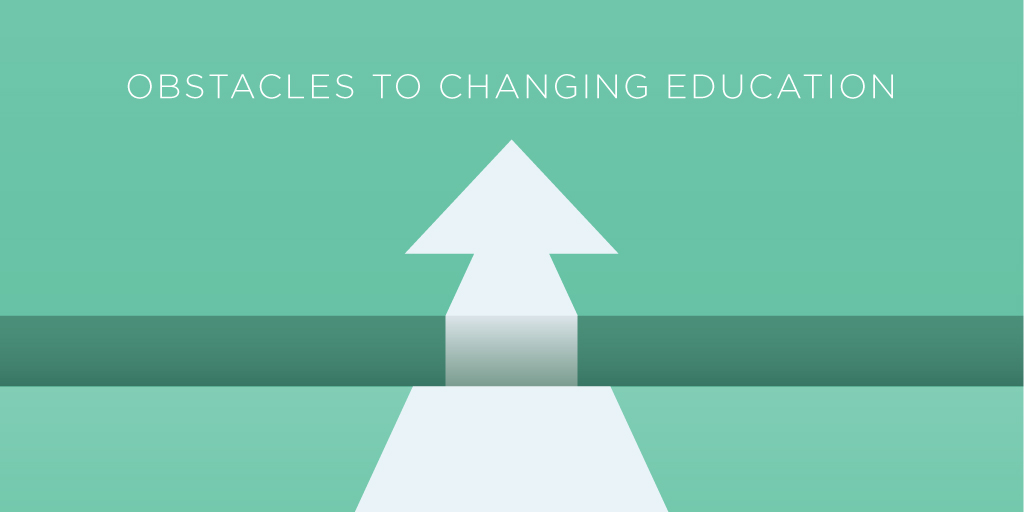
Over the past few decades, there has been a great deal of interest and desire to change, and most of the time improve, public education. Some of these ideas have been innovative, and some less than so. Some have been on a large scale, while some are more at a building level. Some have had political backing (charter schools), while others have had financial backing (think The Bill and Melinda Gates Foundation or Summit Education founded by Facebook CEO Mark Zuckerberg).
So, what does all this focus on “change” matter for a school building? Or does it not matter at all? Are the teachers or the principals in individual buildings impacted by these changes? Many experts, some more expert than others, have many opinions about what should or should not be going on in schools. But what impact does this have on schools that are trying to improve from the inside?
What’s Standing in the Way of Change?
I would contend the answer is that the impact is more than we probably realize. As schools try to improve, sometimes the “system” around them stands in the way of any real change. This is an irony to the efforts pushed outside the system—sometimes they make change harder and not easier for schools. When you add to this all of the federal and state requirements for things like special education, Title 1, and the ESSA act, there can be numerous obstacles in the path to improving education for students.
In our state, we're hearing more and more about “redesigning” schools. We're thinking about how to redesign around the learner and what our future needs as opposed to designing around system or tradition. At times, when the case is made for a need to redesign, I feel like there's been some assumptions made and some fingers pointed.
Not always, but sometimes the onus to redesign comes from the idea that schools have “failed kids” over the past few decades. The collective wisdom is that institutions might be slow to change, teachers may be unwilling to embrace new ideas, or leaders don't have the courage or the wherewithal to make things happen. In my experience, none of these are in any way accurate. There are, of course, institutional issues and teachers who would rather not change, but in general, the educators I know are passionate about student success and want to make a difference.
If that is the case, what’s standing in their way? Here are a few obstacles:
Graduation: Students graduate through credits—this is pretty universal. We know that learning takes place across curricular areas with science, math, and engineering all happening at once. But until we can create courses around learning and not around teaching, this will be next to impossible. Some states have experimented with some courses such as construction geometry, where the concepts are applied in a cross-curricular sense, but the current credit system doesn’t reward this kind of innovation, it actually makes it harder.
Seat time: Most states count minutes or hours for grade levels and for graduation. The reality is that the way we calculate student learning time drives a lot of what we do. I can see why these are important—there needs to be some expectation for how much teaching should take place in a year. But unless there is more flexibility, it is very difficult to change the way in which we learn. We all know that learning takes place in a multitude of ways on a multitude of levels in a multitude of locations, but none of that “counts” in the eyes of the state when it comes to requirements. I spent a number of hours one year teaching social skills to classes in the lunchroom. We would learn a skill and then practice and apply it in a social setting. I would contend that these are essential skills for students to master, but lunch time doesn’t count as instructional time.
Assessments: I think most any parent would tell you that all of their children are different. Some learn fast while others learn more slowly. Even though this is a universal truth, we assess students as though all of them learn at the same rate in the same way. Again, I don’t dismiss the need for assessments and testing, but as long as states drive the assessment train in the way that they have under No Child Left Behind, the schools will be following the lead of the assessment, not of the learner.
These are just three examples, but I think they tell the tale of the challenge that educators have in front of them—a need to reform, a better way ahead, but obstacles in their path of moving forward. This does not mean that progress can’t be made; if we know the rules, we can know how to operate within them. Schools have to get creative to meet students’ needs, which is an unfortunate reality in schools today.
Want to connect with fellow educators to discuss how to drive change in your school? Consider joining MimioConnect™, our interactive teaching community.



